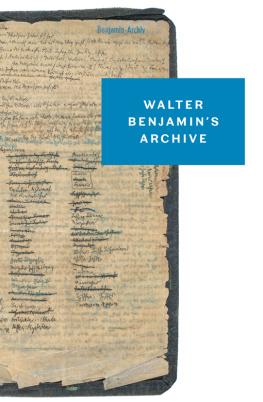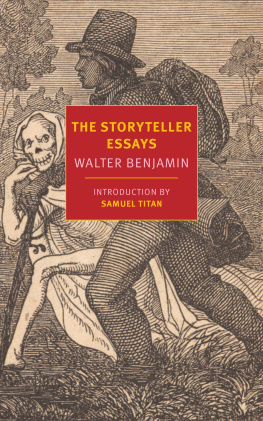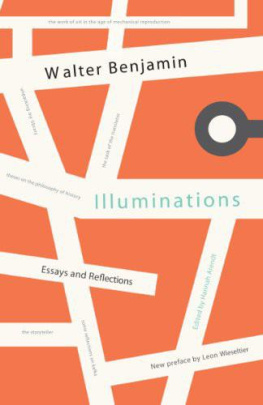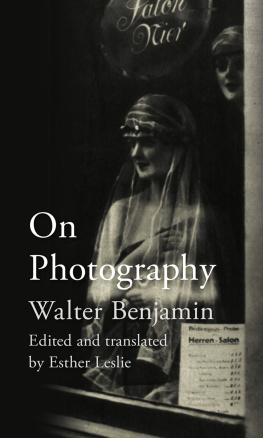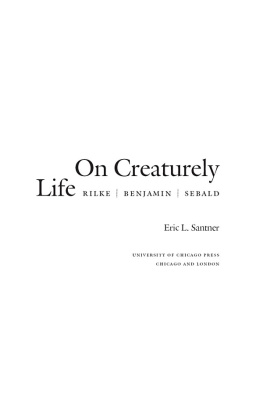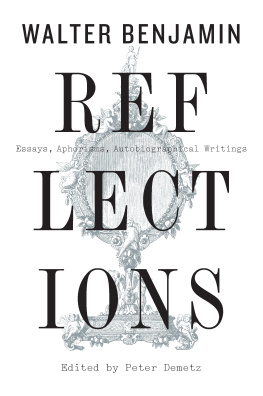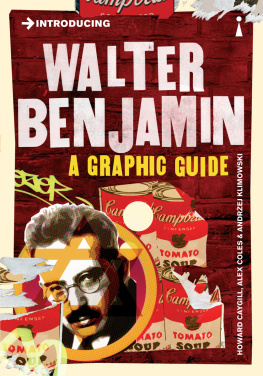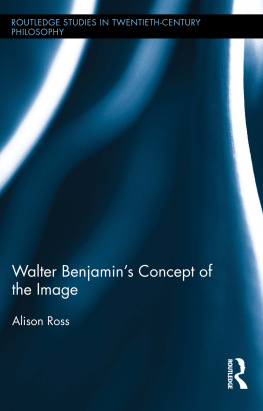Walter Benjamin - The Work of Art in the Age of Mechanical Reproduction
Here you can read online Walter Benjamin - The Work of Art in the Age of Mechanical Reproduction full text of the book (entire story) in english for free. Download pdf and epub, get meaning, cover and reviews about this ebook. year: 2008, publisher: Penguin Books, genre: Art. Description of the work, (preface) as well as reviews are available. Best literature library LitArk.com created for fans of good reading and offers a wide selection of genres:
Romance novel
Science fiction
Adventure
Detective
Science
History
Home and family
Prose
Art
Politics
Computer
Non-fiction
Religion
Business
Children
Humor
Choose a favorite category and find really read worthwhile books. Enjoy immersion in the world of imagination, feel the emotions of the characters or learn something new for yourself, make an fascinating discovery.

- Book:The Work of Art in the Age of Mechanical Reproduction
- Author:
- Publisher:Penguin Books
- Genre:
- Year:2008
- Rating:3 / 5
- Favourites:Add to favourites
- Your mark:
- 60
- 1
- 2
- 3
- 4
- 5
The Work of Art in the Age of Mechanical Reproduction: summary, description and annotation
We offer to read an annotation, description, summary or preface (depends on what the author of the book "The Work of Art in the Age of Mechanical Reproduction" wrote himself). If you haven't found the necessary information about the book — write in the comments, we will try to find it.
The Work of Art in the Age of Mechanical Reproduction — read online for free the complete book (whole text) full work
Below is the text of the book, divided by pages. System saving the place of the last page read, allows you to conveniently read the book "The Work of Art in the Age of Mechanical Reproduction" online for free, without having to search again every time where you left off. Put a bookmark, and you can go to the page where you finished reading at any time.
Font size:
Interval:
Bookmark:
Walter Benjamin
18921940
Walter Benjamin
TRANSLATED BY J . A . UNDERWOOD
PENGUIN BOOKS GREAT IDEAS
PENGUIN BOOKS
Published by the Penguin Group
Penguin Books Ltd, 80 Strand, London WC2R 0RL , England
Penguin Group (USA) Inc., 375 Hudson Street, New York, New York 10014, USA
Penguin Group (Canada), 90 Eglinton Avenue East, Suite 700, Toronto, Ontario, Canada M4P 2Y3 (a division of Pearson Penguin Canada Inc.)
Penguin Ireland, 25 St Stephens Green, Dublin 2, Ireland (a division of Penguin Books Ltd)
Penguin Group (Australia), 250 Camberwell Road, Camberwell, Victoria 3124, Australia (a division of Pearson Australia Group Pty Ltd)
Penguin Books India Pvt Ltd, 11 Community Centre, Panchsheel Park, New Delhi 110 017, India
Penguin Group (NZ), 67 Apollo Drive, Rosedale, North Shore 0632, New Zealand (a division of Pearson New Zealand Ltd)
Penguin Books (South Africa) (Pty) Ltd, 24 Sturdee Avenue, Rosebank, Johannesburg 2196, South Africa
Penguin Books Ltd, Registered Offices: 80 Strand, London, WC2R 0RL , England
www.penguin.com
The Work of Art in the Age of Mechanical Reproduction first published 1936
Franz Kafka first published 1934
Picturing Proust first published 1929
This translation first published 2008
Translation copyright J. A. Underwood, 2008
All rights reserved
The moral right of the translator has been asserted
Except in the United States of America, this book is sold subject to the condition that it shall not, by way of trade or otherwise, be lent, re-sold, hired out, or otherwise circulated without the publishers prior consent in any form of binding or cover other than that in which it is published and without a similar condition including this condition being imposed on the subsequent purchaser
ISBN: 978-0-141-96342-6
The establishment of the fine arts and their division into various categories go back to a time that differed radically from ours and to people whose power over things and circumstances was minute in comparison with our own. However, the astounding growth that our resources have undergone in terms of their precision and adaptability will in the near future confront us with very radical changes indeed in the ancient industry of the beautiful. In all arts there is a physical component that cannot continue to be considered and treated in the same way as before; no longer can it escape the effects of modern knowledge and modern practice. Neither matter nor space nor time is what, up until twenty years ago, it always was. We must be prepared for such profound changes to alter the entire technological aspect of the arts, influencing invention itself as a result, and eventually, it may be, contriving to alter the very concept of art in the most magical fashion.
Paul Valry, Pices sur lart
When Marx set out to analyse the capitalist mode of production, that mode of production was in its infancy. Marx so ordered his endeavours that they acquired prognosticative value. Looking back at the basic circumstances of capitalist production, he presented them in such a way as to show what capitalism might be thought capable of in years to come. What emerged was that it might not only be thought capable of increasingly severe exploitation of proletarians; ultimately, it may even bring about conditions in which it can itself be done away with.
The transformation of the superstructure, which proceeds far more slowly than that of the substructure, has taken more than half a century to bring out the change in the conditions of production in all spheres of civilization. Only now can the form that this has assumed be revealed. Of those revelations, certain prognosticative demands need to be made. However, such demands will be met not so much by propositions concerning the art of the proletariat after it has seized power, let alone that of the classless society, as by propositions concerning how art will tend to develop under current conditions of production. The dialectic of those propositions makes itself no less apparent in the superstructure than in the economy. It would be wrong, therefore, to underestimate the combative value of such propositions. They oust a number of traditional concepts such as creativity and genius, everlasting value and secrecy concepts whose uncontrolled (and at the moment scarcely controllable) application leads to a processing of the facts along the lines of Fascism. The following concepts, here introduced into art theory for the first time, differ from more familiar ones in that they are quiteuseless for the purposes of Fascism. They can, on the other hand, be used to formulate revolutionary demands in the politics of art.
In principle, the work of art has always been reproducible. What man has made, man has always been able to make again. Such copying was also done by pupils as an artistic exercise, by masters in order to give works wider circulation, ultimately by anyone seeking to make money. Technological reproduction of the work of art is something else, something that has been practised intermittently throughout history, at widely separated intervals though with growing intensity. The Greeks had only two processes for reproducing works of art technologically: casting and embossing. Bronzes, terracottas and coins were the only artworks that they were able to manufacture in large numbers. All the rest were unique and not capable of being reproduced by technological means. It was wood engraving that made graphic art technologically reproducible for the first time; drawings could be reproduced long before printing did the same for the written word. The huge changes that printing (the technological reproducibility of writing) brought about in literature are well known. However, of the phenomenon that we are considering on the scale of history here they are merely a particular instance though of course a particularly important one. Wood engraving is joined in the course of the Middle Ages by copperplate engraving and etching, then in the early nineteenth century by lithography.
With lithography, reproductive technology reaches a radically new stage. The very much speedier process represented by applying a drawing to a stone as opposed to carving it into a block of wood or etching it onto a copperplate enabled graphic art, for the first time, to market its products not only in great numbers (as previously) but also in different designs daily. Lithography made it possible for graphic art to accompany everyday life with pictures. It started to keep pace with printing. However, in these early days it was outstripped, mere decades after the invention of lithography, by photography. With photography, in the process of pictorial reproduction the hand was for the first time relieved of the principal artistic responsibilities, which henceforth lay with the eye alone as it peered into the lens. Since the eye perceives faster than the hand can draw, the process of pictorial reproduction was so enormously speeded up that it was able to keep pace with speech. The film operator, turning the handle in the studio, captures the images as rapidly as the actor speaks. Whilst in lithography the illustrated magazine was present in essence, in photography it was the sound film. The technological reproduction of sound was tackled at the end of the last [nineteenth] century. These convergent endeavours rendered foreseeable a situation that Paul Valry described in the sentence: Just as water, gas and electric power come to us from afar and enter our homes with almost no effort on our part, there serving our needs, so we shall be supplied with pictures or sound sequences that, at the touch of a button, almost a wave of the hand, arrive and likewise depart.
Font size:
Interval:
Bookmark:
Similar books «The Work of Art in the Age of Mechanical Reproduction»
Look at similar books to The Work of Art in the Age of Mechanical Reproduction. We have selected literature similar in name and meaning in the hope of providing readers with more options to find new, interesting, not yet read works.
Discussion, reviews of the book The Work of Art in the Age of Mechanical Reproduction and just readers' own opinions. Leave your comments, write what you think about the work, its meaning or the main characters. Specify what exactly you liked and what you didn't like, and why you think so.



